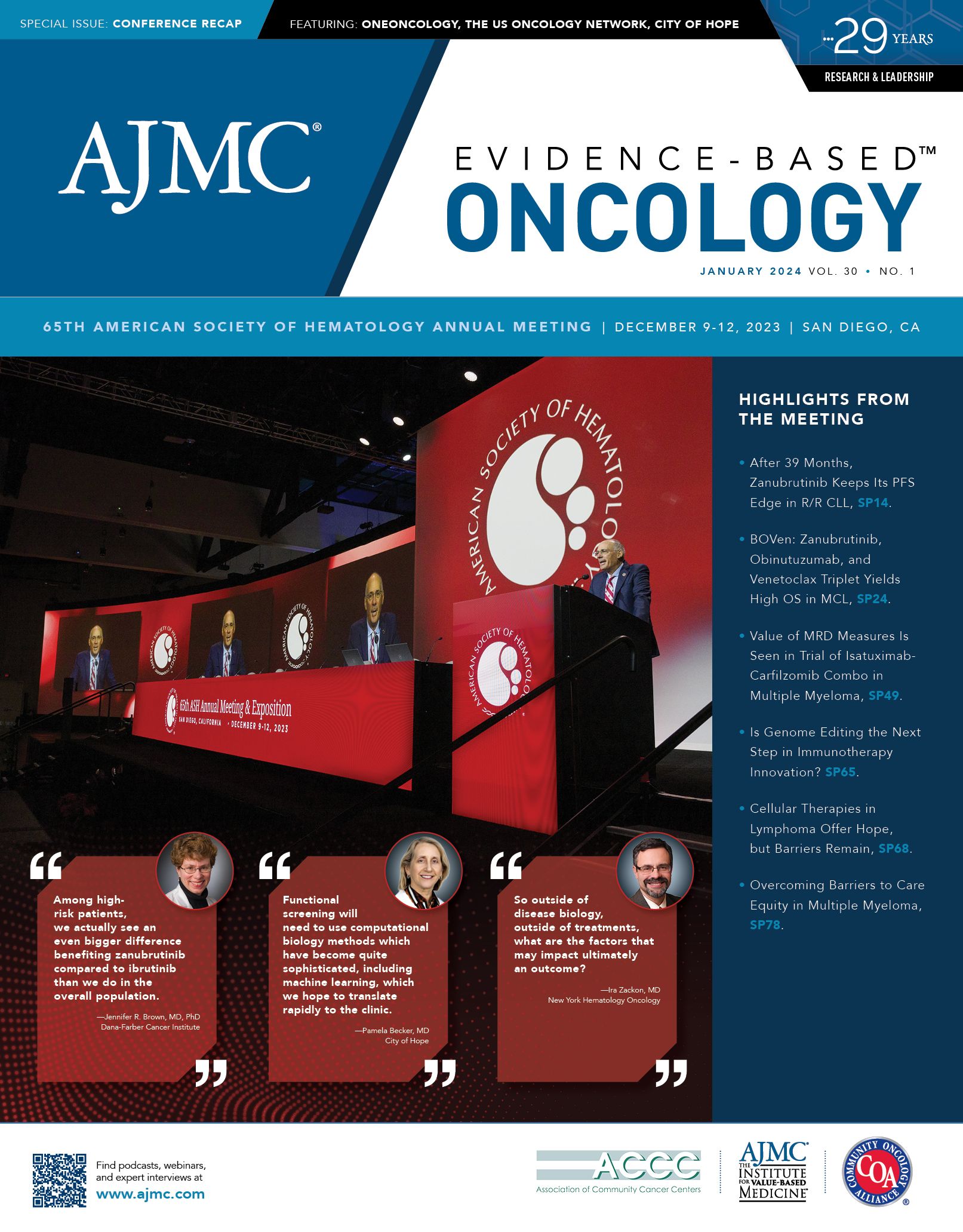- Center on Health Equity and Access
- Clinical
- Health Care Cost
- Health Care Delivery
- Insurance
- Policy
- Technology
- Value-Based Care
Overcoming Barriers to Care Equity in Multiple Myeloma
In recent decades, a wealth of research and the development of highly effective therapies have led to markedly improved outcomes for patients with multiple myeloma, but these benefits have not been shared across all populations. The burden of multiple myeloma remains substantially higher among Black patients compared with White patients, with outcome disparities driven primarily by unequal access to novel treatments and underrepresentation in research and trials, according to presenters at the 65th American Society of Hematology (ASH) Annual Meeting and Exposition, held December 9 to 12, 2023, in San Diego, California.
Yvonne Efebera, MD, MPH | Image: OhioHealth

Srinivas Devarakonda, MD | Image: Ohio State University

In a scientific spotlight session, cochairs Yvonne Efebera, MD, MPH, of OhioHealth, and Srinivas Devarakonda, MD, assistant professor at The Ohio State University College of Medicine, spoke about the crucial, persistent issue of health inequalities in multiple myeloma care in the United States in a presentation titled “Tackling Greater Burden of Multiple Myeloma in African American Patients.”
“Disparities in health outcomes for African American patients with multiple myeloma have been an unfortunate and unacceptable part of research and health care for several decades,” Devarakonda began. He emphasized that although survival overall has improved significantly in recent decades for patients with multiple myeloma, the disease-specific survival improvements seen among White patients have not been shared by Black patients.
Devarakonda highlighted the disproportionate underrepresentation of Black patients in clinical trials and genomic studies, as well as disparities in access to and use of novel drugs and cellular therapies in Black patients, as drivers of the disparities seen in outcomes.
Efebera started with an overview of the disparities seen in multiple myeloma care and outcomes, noting that Black patients experience both increased disease incidence and poorer outcomes compared with White patients. She highlighted findings from a study published in Blood, which concluded that unequal access to care and/or different responses to novel therapies may drive these differences.1
A more recent analysis of SEER (Surveillance, Epidemiology, and End Results Program) data showed that although the 10-year relative survival rate nearly doubled among non-Hispanic White and Hispanic patients in 2003 to 2007 vs 1993 to 1997, non-Hispanic Black patients saw a significantly smaller improvement.2 Yet, data from an even more recent study showed that with equal access to care, multiple myeloma survival was superior among Black patients compared with White patients in the Veterans Affairs health system, suggesting observed disparities are primarily due to socioeconomic factors, and that Black patients may have favorable disease biology compared with White patients.3
Identifying and Addressing the Sources of Multiple Myeloma Care Disparities
“What are the factors affecting access and outcomes of Black patients with multiple myeloma? Biologic differences, social and environmental differences, institutional factors, provider, and patient factors,” Efebera explained.
Research findings suggest there are biologic differences in Black patients with multiple myeloma compared with White patients, Efebera noted. However, those differences point to less high-risk disease among Black patients, meaning outcomes should theoretically be better than outcomes seen in White patients.
These findings suggest that reduced access to appropriate care due to a range of factors drives the disparate outcomes seen in Black patients with multiple myeloma in the United States. Social barriers include access to and type of health insurance, health literacy, household income, area of residence, and lack of awareness around medical advances, Efebera said, highlighting a range of data spotlighting the impact of these barriers.
“These data indicate that socioeconomic strata and insurance coverage are important underlying determinants of the identified disparities,” Efebera said. “Strategies to improve access need to be framed around addressing the causes of these observed disparities.”
Institutional barriers including lack of diversity in health care teams, a lack of infrastructure, the location of care received, and systemic racism also contribute to disparities. Efebera also emphasized a lack of clinical trial openings for novel therapies such as bispecific antibodies or chimeric antigen receptor (CAR) T-cell therapies in US states with the highest percentage of African American residents.
Provider-level biases, underutilization of care, underutilization of support staff, a lack of support for research opportunities, racial discordance, and a lack of cultural competency also fuel disparities in care. Awareness of these barriers and efforts to reduce and neutralize biases are crucial in this setting, Efebera explained. Cultural competency training is key, starting in medical school and at all levels of care.
Efebera proposed a range of potential avenues for improvement, including increasing access through expansion of the Affordable Care Act (ACA) and creating or expanding a task force to work closely with federal agencies to improve the ACA. The development of studies to further assess the biologic differences and drug responses across racial and ethnic groups is also crucial, as is developing strong collaboration and trust between community hematologists and academic hematologists.
Work in the community is also extremely important, including increasing education efforts at gathering places such as community centers and churches, as well as encouraging routine primary care and seeking help early. For patients, building trust in providers is also important, as many patients have likely had negative experiences in health care settings, Efebera noted.
Clinical Trial Restructuring to Increase Access and Reduce Disparities
“Incidence and mortality of multiple myeloma in African American patients is twice as high as [that of] Caucasian patients, yet their representation in clinical trials is not even half that of Caucasian patients,” Devarakonda explained. “The lack of racial and ethnic diversity is a major shortcoming of clinical and genomic research in multiple myeloma currently.”
Racial and ethnic diversity in clinical trials is crucial to reflect real-world populations and ensure results are generalizable to all patients treated in the clinical setting. Additionally, it allows for the study of disease biology and therapy responses, as well as potential identification of molecular subtypes that could help improve targeted treatments, Devarakonda said.
Additional enrollment of Black patients in clinical trials has decreased in recent years, and enrollment in trials for novel agents is particularly low.4
Currently, a variety of trial-related, patient-related, and institutional barriers must be overcome to achieve equity in clinical trials, and these are largely the same barriers preventing equitable access to myeloma care overall.
Trial-related obstacles range from trial design and eligibility criteria to site locations, as well as study requirements in terms of protocol and follow-up. Patient-related factors are care access, insurance, comorbidities, and health literacy, among others. Clear enrollment goals, involvement of patient advocates on trial teams, tapping lived experience experts, and incorporating diversity in the workforce are a few ways these areas can be addressed.
Eligibility criteria have been a substantial barrier for Black patients, and creating criteria that help meet enrollment goals of having 18% to 20% Black patients in trials is important, Devarakonda explained.
Criteria must be reviewed to determine their impact on eligibility for Black patients, as well as on trial objectives and patient safety. Considering race-related changes in normal values for hematological parameters and avoiding exclusion criteria with no scientific evidence are also key, Devarakonda said. Importantly, reviewing criteria should be an ongoing, dynamic process. He noted that one hot topic has been the potential use of artificial intelligence in eligibility criteria evaluation.
From an industry standpoint, bringing clinical trials to states and cities with the highest Black populations would foster higher enrollment. Devarakonda stressed the importance of making trials available in community settings, where most Black patients receive their care, and the need to support large academic centers that can assist community oncology practices. Diversity officers can also track and support representation goals from the industry side.
Raising awareness about trials through innovative advertising, making information available in areas of congregation that are nonclinical, and engaging community physicians and advocacy groups to share information can help keep communities informed. And for trial investigators, Devarakonda reiterated that working with community oncologists and providing them with clear information and support with trial execution, as well as assurance that patients will continue with the community practice’s care after the trial concludes, are key aspects of bringing clinical trials to more patients.
Overall, being proactive about addressing barriers to equitable care is the way forward to reduce disparities in multiple myeloma. This takes many forms and is a task necessitating commitment from various stakeholders, including providers, industry, and trial investigators. Devarakonda noted that ASH has even put together a Diversity, Equity, and Inclusion Toolkit for Clinical Trials that can help trial sponsors incorporate principles of equity throughout the course of trials.
“It takes a village to achieve health equity for everyone in multiple myeloma, but it is an achievable goal—I want to emphasize that,” Devarakonda concluded. “It just requires ongoing collaborative efforts of investigators, institutions, community practices, industry, regulatory agencies, and policy makers.”
References
1. Waxman AJ, Mink PJ, Devesa SS, et al. Racial disparities in incidence and outcome in multiple myeloma: a population-based study. Blood. 2010;116(25):5501-5506. doi:10.1182/blood-2010-07-298760
2. Costa LJ, Brill IK, Omel J, Godby K, Kumar SK, Brown EE. Recent trends in multiple myeloma incidence and survival by age, race, and ethnicity in the United States. Blood Adv. 2017;1(4):282-287. doi:10.1182/bloodadvances.2016002493
3. Fillmore NR, Yellapragada SV, Ifeorah C, et al. With equal access, African American patients have superior survival compared to white patients with multiple myeloma: a VA study. Blood. 2019;133(24):2615-2618. doi:10.1182/blood.2019000406
4. Ailawadhi S, Jacobus S, Sexton R, et al. Disease and outcome disparities in multiple myeloma: exploring the role of race/ethnicity in the Cooperative Group clinical trials. Blood Cancer J. 2018;8(7):67. doi:10.1038/s41408-018-0102-7

Mental Health Diagnoses, Care Challenges Rise Among US Youth, Report Finds
April 26th 2024While behavioral health care utilization has been rising, the treatment landscape has been worsening. New findings show that 20% of youths did not receive any form of treatment within 3 months of their initial behavioral health diagnosis.
Read More
Empowering Community Health Through Wellness and Faith
April 23rd 2024To help celebrate and recognize National Minority Health Month, we are bringing you a special month-long podcast series with our Strategic Alliance Partner, UPMC Health Plan. In the third episode, Camille Clarke-Smith, EdD, MS, CHES, CPT, discusses approaching community health holistically through spiritual and community engagement.
Listen
Overcoming Employment Barriers for Lasting Social Impact: Freedom House 2.0 and Pathways to Work
April 16th 2024To help celebrate and recognize National Minority Health Month, we are bringing you a special month-long podcast series with our Strategic Alliance Partner, UPMC Health Plan. Welcome to our second episode, in which we learn all about Freedom House 2.0 and the Pathways to Work program.
Listen
